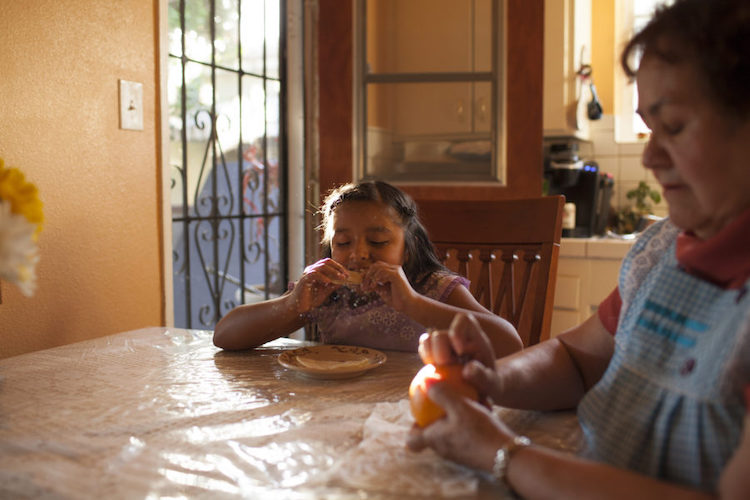
Image by Shestock/Getty Images, © All Rights Reserved.
Before the Resurrection, There Is a Simple Meal
“If you really want to make a friend, go to someone’s house and eat with him…the people who give you their food give you their heart.”
— César Chávez
I am a theological nomad by heart. Although I call the non-denominational church my home, I know I can always come home to where God feels most comfortable and deeply present: my abuela’s kitchen, a sanctuary of rich textiles and homemade pastries where the pan de huevo (sweet bread) is a staple. This is especially true during Lent, when I long for traditional foods even if they don’t mean to me what they once did.
When my family left the Catholic Church for new and boisterous adventures in different denominations, we lost the meaning behind some foods rich in family tradition. Our family grew weary of “that’s how it’s always been,” and we navigated the spaces between faith and Latinidad like a holy balancing act. At first, it felt freeing. Decades later, it would feel like mourning.
Now, with a family of my own, I yearn for liturgy. In the throes of raising children to be faithful to who they are and respectful of the generations that have led us here, I bend my knees in mercy more than I can count. I long for sacred family traditions, a praxis I can pass on to them. I’ve become engrossed with shedding old ways of navigating my faith, and my children remind me that there is so much to hold on to. I fear in neglecting the significance behind time-honored family foods, we will also lose our stories.
When I mourn the loss of sacred meanings, I imagine my favorite dessert. Capirotada is a traditional Mexican Lenten bread pudding made, by my abuela, of bolillos, cinnamon sticks, cheese, cloves, and pecans. This soggy, sweet, and earthy bread is a reminder that we, of Mexican-American heritage, are sacrificial followers of the Most High. Lent calls many Christians to observe the sacrifice Jesus Christ made when he was lured to the desert without food or drink for 40 days. His faith was tested, which is why many Christians fast from something important to them for the 40 days leading up to Easter. Lent reminds us that we have purpose in life’s wild journey through sacrifice and resurrection.
We rarely bake capirotada. I miss the stories we once shared whilst sitting at the table marinating bread in piloncillo syrup, adding layers of cheese symbolic of a holy linen shroud, and tossing raisins and pecans atop the pyramid-shaped bread like a rain dance. I miss Abuela’s perfectly bobby-pinned hair, a deep brunette mound at the top and a curtsy at the bottom. Her amethyst teardrop earrings indicative of paying penance, but in fashion. Everything had its proper place — so when we decided to abandon tradition, it felt like we were leaving behind our most valued possessions.
Along with the abandonment of saints, prayer cards, Virgen de Guadalupe candles, hand carved rosaries, and palo santo, we left behind the sacredness of capirotada. My family found new ways of adapting to foods that made it clear we were no longer bending our knees in routine liturgy on Sunday mornings. A quick stop at a taqueria or an after-church lunch at Luby’s Cafeteria would suffice. Everything became a quick order, like a Starbucks of the spirit: one-hour church services, rock ‘n roll worship sessions. Our religious life is a venti with double shots of pride and a taste of macchiato, because who doesn’t like a kick in their worship?
I’ve grown weary of empty fixes of the spirit. This particular Sunday, my husband, children, and I visit my grandparents hoping to recenter the mind and the stomach. It is Lent, but we will not call it that. Instead, we’ll share a meal as if it were any other Sunday, and I’m okay with that.
Abuela prepares a caldo which makes me miss every bit of theology I’ve walked away from. She ladles the rice on the bottom of the bowl, then the broth, two pieces of res (meat), and she piles the cabbage, carrots, celery, and cilantro on top. Before the mouth can taste the meat, it first has to slush through tender vegetables. It is like convincing our mouth that what comes next will also be good for us. She places the corn cob in a separate bowl because it should never be eaten soggy. It should be enjoyed as our ancestors enjoyed it, crunchy and milky at first bite.
“Food should always surprise you when you bite it,” my abuelo says as he grabs his bowl of corn from Abuela’s hands.
It is this exchange of knowledge and the physical handling of food which makes me ask myself if I can carry on the stories of our food, even if their meanings have changed. When lured to the desert tempted to create new traditions, I must first be willing to honor the stories which have brought me here. This is what it means to carry a story well. No matter how many times we eat or share a meal there will always be new treasure to discover.
We spoon the last of the caldo into our mouths ready to hunch over the table because we are filled to the brim with great soup. From the oven, Abuela pulls out a huge sheet pan covered with aluminum foil. The aroma of cloves wafts out of the unfolded edges. She reveals her homemade capirotada, and the room becomes still like the photograph above the china cabinet.
It is a photograph of six generations of women who each carry a story of labor. They hold one another’s hands, indicative of hanging on. I am one of those six. From left to right: Ma Grande, Ma Petra, Mamá Mary, Abuela and my Ma. Then, there is me.
Each of us is tasked with the responsibility of story. Each woman holds a blessing in her hand — the hand of the woman she bore. Each of us is entrusted with the sacredness of food and story.
Abuela confesses, “This time, I used walnuts and not pecans like Mamá Mary used to make it.”
In her purest forms, pre- and post-colonization, food begs us to carry her in the stories we pass on from generation to generation. Food implores us to have faith when we know the outcome of a recipe we’ve carried on for decades may change at the mood of the cook. What happens in our mouths when we inhale and bite, moisten the food, and swish it around our palate is ritual. It is sacred. It is remembrance.
In the continual journey of faith, the food at our table and its meaning often change — perhaps it is our ongoing assimilation. Our prayers evolve to include farmworkers, and the Our Father has never left our tongues. The head coverings we once used to enter a cathedral are neatly folded in drawers we may never open again, but we will still remember.
Capirotada is a peace offering for the varied ways I’ve subscribed to showing up at God’s doorstep. I don’t commemorate this dessert as I once did, yet this bread pudding doesn’t let me forget that it has a story that yearns to be told. It wants to be passed on to my children and theirs. I feel a tug on my spirit. Today, we’ve come together in remembrance. We’re gathered in Abuela’s kitchen honoring who and what is no longer with us. This is an unspoken Lent.
My family pulls God from the oven of our minds and fashions the idea of sacrament as we eat. Before the laying down of transgressions, there is an uprising of conversation and food enjoyed in merriment. Before death, there is absolute life at a dining room table. Before we point out what separates us, we celebrate why we are a part of each other in the world. Before the resurrection, there is a simple meal.
Salazar y Cisneros Capirotada Recipe
Prep Time: 10 minutes
Cook Time: 30-35 minutes
Total Time: 45 minutes
Serves: 8 comfortably
Ingredients (household recipes will vary)
4 cups of water
2 piloncillos
2 cinnamon sticks
4 whole cloves
6 bolillos torn up in large pieces (you can also use bread slices)
1 cup of raisins (optional – I’m not a fan)
1 cup of walnuts or pecans (or both)
1 pack of yellow cheese slices (or queso fresco depending on your budget)
Instructions
- Preheat the over to 350 degrees
- In a small saucepan, combine the water, piloncillos, cinnamon, raisins, and cloves over high heat. Bring it to a boil.
- As soon as it comes to a boil, lower the heat and simmer it for a few minutes. Strain the syrup from the chunks. Put the raisins back into the syrup. Set the syrup aside.
- Use a nonstick pan to layer 3 – 4 layers of each ingredient. For example, layer one at the bottom with pieces of bolillos. Drizzle some syrup. Layer two with raisins and nuts combined. Drizzle some syrup. Layer three with cheese slices. No syrup drizzle after this layer. Repeat until the last layer is only bolillos.
- Pour the remaining syrup, raisins, and nuts on top.
- Back for 30 – 35 minutes until golden brown.
- If you’re feeling extra American, add vanilla ice cream on the side. My abuela sure loves it this way.
- Enjoy with family after prayer.
Remember each time you make it you may want to add more or less water to the syrup depending on how soggy you would like your dessert.

Share your reflection